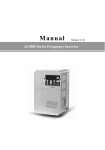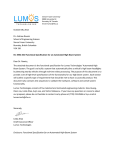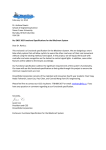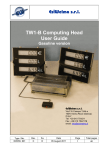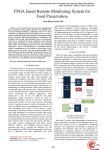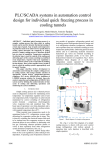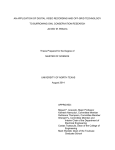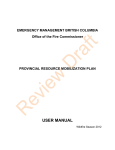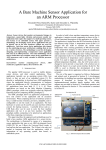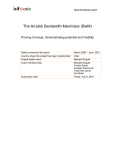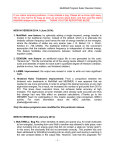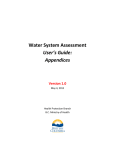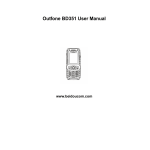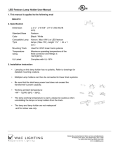Download Wael Jendli - Simon Fraser University
Transcript
February 17, 2014 Dr. Andrew Rawicz School of Engineering Science Simon Fraser University Burnaby, BC V5A 1S6 Re: ENSC 440 Functional Specification for a Bicycle Smart Helmet Dear Dr. Rawicz, Please accept the following document as a functional specification for our Smart Helmet project. We aim to design and implement a bicycle helmet that makes biking a safer and more enjoyable experience for the community. Our design consists of a helmet with mainly break and turn signals that help bikers announce their presence and intentions to other road users. The purpose of this functional specification is to present an overview of the functionality of the proposed product without extreme design content. Our team will use this document, through the completion of the product. Cycle Bright Solutions consists of five determined and talented 4th year engineering students: Wael Jendli, Arta Ahrabi, Chakaveh Ahmadizade, Ahmed Medhioub and Ibrahim Appiah. If you have any questions, or concerns about our functional specification, please feel free to contact Ahmed Medhioub at 778-829-7307 or by email at [email protected]. Sincerely, Wael Jendli Wael Jendli Chief Executive Officer Cycle Bright Solutions Enclosure: Functional Specification for a Bicycle Smart Helmet Functional Specification Functional Specification for a Bicycle Smart Helmet Project Team Chakaveh Ahmadizade Arta Ahrabi Ibrahim Appiah Wael Jendli Ahmed Medhioub Contact Person Ahmed Medhioub [email protected] Submitted to Dr. Andrew Rawicz - ENSC 440 Steve Whitmore - ENSC 305 School of Engineering Science Simon Fraser University Issued Date February 17, 2014 Revision 1.1 Executive Summary Over the last year, cyclists in Vancouver were involved in 1400 incidents on average, with 100% injuries rate according to ICBC. Most of those accidents were the consequence of miscommunication between cyclists and other road users especially when turning or changing lanes. Indeed, cyclists need to use hand signals while keeping the other hand on the handle which makes it hard to keep a straight line. Thus, the objective of our project is to provide cyclists with a safer and more enjoyable riding experience through our smart helmet. In fact, we are designing and implementing turn signals and brake lights at the back of the helmet that can be triggered wirelessly without taking the hands off the handle. To make the helmet more attractive, it will have Bluetooth capabilities and the ability to connect it to a phone or a music device without the safety of the cyclists at risk. The helmet could be used as well for other activities s such as skate boarding or rollers. The development of this product will be done in three stages: two development stages to obtain a proof-of concept and a third stage to obtain a final production product as follows: Development stage I: Build the main functionality of the Helmet i.e. the turning signals A Portable triggering circuit to turn on and off the corresponding lights Development stage II: Additional features are added to the Helmet Fall detection and notification should be added to the helmet Bluetooth capabilities are integrated with the system At the end of the second stage a working proof-of-concept should be delivered no later than the 15th, April 2014. Furthermore, the helmet should comply with any standards and regulation and should continue to provide its main purpose of keeping the cyclists safe from brain damages or major concussions. In the following document, detailed functional specifications are outlined for the system as well as for its main subsystems. Thus, it is intended to be used by the designers, developers and testers of the system as guideline and updated as necessary. © 2014, Cycle Bright Solutions ii Table of Contents Executive Summary ............................................................................................................... ii Table of Contents ................................................................................................................. iii List of figures and tables ....................................................................................................... iv Glossary ............................................................................................................................... iv 1. Introduction ...................................................................................................................... 1 1.1 Scope............................................................................................................................... 1 1.2 Intended Audience........................................................................................................... 1 1.3 Classification.................................................................................................................... 2 2.1 System Overview ............................................................................................................. 3 2.1.1 Development stage I ..................................................................................................... 3 2.1.2 Development stage II .................................................................................................... 4 2.2 General Requirements ..................................................................................................... 5 2.3 Electrical Requirements ................................................................................................... 5 2.4 Physical Requirements ..................................................................................................... 6 2.5 Environmental Requirements ........................................................................................... 6 2.6 Reliability and Durability .................................................................................................. 6 2.7 Sustainability and Safety .................................................................................................. 6 2.8 Usability Requirements .................................................................................................... 7 2.9 Standards ........................................................................................................................ 7 3.1 General Requirements ..................................................................................................... 7 3.2 Physical Requirements ..................................................................................................... 8 3.3 Mechanical Requirements-Brake Trigger .......................................................................... 8 3.4 Usability Requirements .................................................................................................... 8 4.1 General Requirements ..................................................................................................... 8 4.2 Electrical and Safety Requirements .................................................................................. 9 5.1 General Requirements ..................................................................................................... 9 5.2 Physical Requirements ..................................................................................................... 9 5.2 Electrical Requirements ................................................................................................... 9 © 2014, Cycle Bright Solutions iii 6.1 General Requirements ................................................................................................... 10 7.1 General Requirements ................................................................................................... 10 7.2 Physical Requirements ................................................................................................... 10 9.1 Triggering Unit Test Plan ................................................................................................ 11 9.2 LED Unit Test Plan .......................................................................................................... 12 9.3 Microcontroller Unit Test Plan ....................................................................................... 12 9.4 Speaker Unit Test Plan ................................................................................................... 12 9.5 Fall detection Unit Test Plan........................................................................................... 12 10. Conclusion ..................................................................................................................... 13 11. References ..................................................................................................................... 14 List of figures and tables Figure 1: High-Level Smart Bicycle Helmet Block Diagram ........................................................................... 3 Figure 2: Example of control box (triggering circuit) [2] ............................................................................... 4 Figure 3: Concept design proposed by Filczer [4] ......................................................................................... 4 Glossary BLE ICBC LED MCU RF RGB SBH Wifi © 2014, Cycle Bright Solutions Bluetooth Low Energy Insurance Corporation of British Columbia Light-Emitting Diode Microcontroller Unit Radio frequency Red-Green-Blue Smart Bicycle Helmet Wireless Fidelity iv Functional Specification 1. Introduction Cycle Bright Solutions believe that the current helmets can greatly benefit from the advancements of technology by the creation of a smart helmet. We aim to create a helmet which will increase the safety of riders by making it easier for cars and cyclists to communicate with each other. The conventional hand signals are inadequate at best and downright dangerous at worst [1]. They require the cyclist to remove one hand from the handle bar to perform hand motions that might throw them off balance and even then, they may be not even be feasible at times due to variety of factors such as grade or conditions of the road. Furthermore, these hand signals can be hard to see in low light conditions. To address these issues, the Cycle Bright Solutions’ helmets will feature an RGB LED panel at the back of the helmet that can display left and right signals as well as brake lights to warn the other cars in a timely manner. Thus, the Smart Helmet will help the riders to signal their directions at any time of day without requiring them to remove their hands from the handlebar. The Cycle Bright Solutions offers an exclusive and unique product that will provide several useful features to outdoor-sport enthusiasts such as signalling, Bluetooth capabilities and potentially geolocation services. The requirements for this smart helmet, as proposed by the Cycle Bright Solutions, are described in this functional specification. 1.1 Scope The scope of this document is to outline the functional requirement of Cycle Bright Solutions’ helmets. This document describes the functionality of the system including the microcontroller, LED signals, triggering circuit, Bluetooth capabilities and the overall system functionality. Furthermore, all detailed function requirements will be discussed, which will be used as a guide during the design, development and testing of the product to ensure a safe and reliable user experience. The specifications and design of some components may change during the testing stage in order to maximize the performance of the system. 1.2 Intended Audience The functional specification is intended for use by all members of Cycle Bright Solutions. Our team should refer to this document in every phase of development to guarantee that the final product meets the predefined function requirements. This document will also help the marketing department of Cycle Bright Solutions team, find investors or advertise for the finalized product. © 2014, Cycle Bright Solutions 1 Functional Specification 1.3 Classification The functional requirement specification is shown as follows: [Rn-p] ‘R’ is an abbreviation for requirement, ‘n’ is the functional requirement number and ‘p’ stands for one the following three development phases: I. Proof-of-Concept stage II. Ongoing developing (both proof-of-concept and final production) stage III. Final production stage © 2014, Cycle Bright Solutions 2 Functional Specification 2. System Requirements The general system requirements and specifications of the Smart Helmet as a complete system are outlined in this section. In addition, specific specifications for the different versions of the product are presented in the following. 2.1 System Overview The Smart Helmet can be represented by the following high-level system block diagram in figure 1. Figure 1: High-Level Smart Bicycle Helmet Block Diagram The smart Helmet consists of two main subsystems which can be designed, implemented and tested separately then further integrated. Due to the time and budget constraints, the proof-of-concept will be built through two development stages. 2.1.1 Development stage I The main goal of the Smart Helmet is to replace the hand signals by turn signals that can be easily triggered by the user. Thus, the first stage of the development will focus solely in delivering such functionality. In other words, this phase will be dedicated to the design and implementation of the triggering circuit and its synchronization with the microcontroller which will be responsible for turning on and switching off the LED signals as per the user request. © 2014, Cycle Bright Solutions 3 Functional Specification The user is able to select the direction of their intended turn via a self explanatory control box similar to the one presented in figure 2. Figure 2: Example of control box (triggering circuit) [2] To avoid interference, the signals from the control box should be sent wirelessly via radio frequency (RF) which has a limited range of 1-10 meters [3] compared to the wider range of 30 meters for Wifi and Bluetooth. After decoding the signal, the corresponding LED signal should be on with the possibility of being turned off as per the user request. At the end of this stage, the helmet should be able to respond to the user input and display the proper signal. A potential resulting design from this stage is illustrated in Figure 3. Figure 3: Concept design proposed by Filczer [4] 2.1.2 Development stage II After designing the main functionality of the SBH, this development stage will focus on adding the break trigger, the fall notification system and the Bluetooth speaker. The break trigger should be integrated with the previous triggering circuit with minimal wiring to insure the portability of the system. When the user breaks, the breaks’ LED signal should turn on and automatically turn off, when the break is released. The main constraint with this part of the triggering is © 2014, Cycle Bright Solutions 4 Functional Specification that the breaks are a mechanical action of the bike that needs to be detected and then wirelessly sent to the microcontroller without any significant modification to the bike. In addition, the fall detection sensor is to be implemented and integrated during this phase of the development. The sensor should detect free falls when the user falls from their bike due to incident. This event must result in a flashing state of the LEDs simulating the hazardous lights available on other vehicles. The difficulty with this part is the ability to detect fall events with reliability and avoid any false negative triggering of the flashing state. Finally, the speaker and microphone unit should be added to the helmet taking into consideration the perfect emplacement and measures to avoid noise interference. Choosing an already made module with Bluetooth capabilities might be the ultimate solution due to the incompatibility of the microcontroller with audio devices. The final production Smart Helmet will incorporate all the features listed with more attention to aesthetics, portability and making sure the SBH complies with DOT and Snell standards. Furthermore, the final helmet should be durable, sustainable and accommodates different sizes. 2.2 General Requirements [R1-II] [R2-II] [R3-II] [R4-II] [R5-II] [R6-III] [R7-III] [R8-III] [R9-III] [R10-III] The SBH must be compatible and adapted to any bike The SBH shall replace the hand signals with a safer turn signal mounted on the helmet The user shall be able to trigger the turn signal simply with a touch of a finger The user input shall be wirelessly transferred to the MCU to switch on the turn signals The SBH must provide visual feedback to the user about the state of the lights The user shall be able to choose the brightness of the turn signals The SBH shall not interfere with other devices or other vehicles The SBH retail price shall be less than $100 THE SBH shall have minimal setup and wiring to the bike The SBH shall conform to the usual helmets in shape, size, weight and material used 2.3 Electrical Requirements [R11-II] [R12-III] [R13-III] [R14-III] [R15-II] The power provided should be sufficient to power up all the components of the SBH The power supply must last for a usual day of cycling (up to 10 hours) The power supply must be eco-friendly and rechargeable On-bike recharging unit might be adopted for further revisions of the SBH All components of the SBH must have an operating point of 3-12V © 2014, Cycle Bright Solutions 5 Functional Specification 2.4 Physical Requirements [R16-II] [R17-III] [R18-III] [R19-II] [R20-III] [R21-II] The Helmet shall be light-weight, waterproof and of a standard size and shape [5] The Helmet shall be of adjustable size to fit almost every user The SBH shall be fully compact and look appealing to a broad range of users The SBH shall have an ear-cover to suppress neighbouring noise The Helmet shall be comfortable, fits securely and provide ample ventilation [6] The triggering circuit should be portable and with a size not exceeding 5x5x3 (cm3) 2.5 Environmental Requirements [R22-III] [R23-III] [R24-III] [R25-III] The SBH shall deliver the same performance under different weather conditions. The SBH shall operate normally under a temperature range of (-5, 35 °C) The SBH shall operate in heavy rains and light snow conditions The SBH shall operate normally in a sea elevation that goes up to 2000 meters 2.6 Reliability and Durability [R26-III] [R27-III] [R28-II] [R29-II] [R30-II] The SBH shall be weather resistant and waterproof The SBH shall be durable for daily normal usage and shall not show signs of wear The SBH shall be relatively accessible to change the batteries or service the LEDs The SBH shall not have an excessive heat dissipation that might endanger the user The lights on the Helmet shall be bright enough to be seen in fog or during day time 2.7 Sustainability and Safety [R31-III] [R32-II] [R33-III] [R34-III] [R35-II] [R36-II] [R37-II] [R38-II] The SBH shall be made of recyclable material and eco-friendly components Rechargeable Lithium batteries shall be used to power the SBH The user shall be able to recharge the SBH as a whole system An eco-friendly charging unit shall be mounted to the bike to use energy produced by the user while cycling The SBH shall be safe to use and shall secure the head from any potential accidents The SBH shall not have any interference with the brain All components shall be well insulated and secure from any electric shock dangers The Helmet shall be made from non-conductive material to avoid lightning effects © 2014, Cycle Bright Solutions 6 Functional Specification 2.8 Usability Requirements [R39-II] [R40-II] [R41-II] [R42-II] The SBH shall be user-friendly and self-explanatory without necessary background knowledge The SBH shall provide visual feedback to the user on the state of the signals The user shall be able to turn the signals on and off without taking their hands off the handle The signals displayed by the SBH shall be intuitive and do not confuse other road users 2.9 Standards For wider marketability of the SBH, the following standards shall be followed [R43-III] The SBH shall conform to CSA D113.2-M89 for cycling Helmets [7] [R44-III] The SBH shall conform to Snell 2005 or Snell 2010 for marketing in the United States [5] [R45-III] The SBH shall conform to the DOT Federal Motor Vehicle Safety Standard No. 218 [5] [R46-III] The SBH shall conform to the United Nations Economic Commission for Europe (ECE) Regulation No. 22 for marketing in Europe [5] [R47-III] The SBH shall conform to the standards of Bluetooth Low Energy (BLE) [8] In the following sections, specific subsystems specification is discussed. 3. Triggering Unit Requirements The triggering unit is composed of various elements that constitute the main part of the user input to the system. Indeed, this unit contains signals buttons that can be activated and deactivated to turn on or off the corresponding signal with some visual feedback to the user. In addition, the break trigger detects when the user used any of the breaks. All the above triggering events and signals are sent to the central MCU via an RF transmitter. 3.1 General Requirements [R48-II] [R49-II] [R50-III] [R51-II] [R52-II] [R53-II] [R54-II] [R55-I] Primary means of user input shall be through a set of buttons and switches Triggers shall be easy to use with least amount of focus All parts of the triggering unit shall be easily installed on any bicycle Triggering unit shall provide efficient feedback to the user to avoid confusion Triggering unit shall not distract user from the road RF shall have four combinations of signals, A, B, C and D to select different triggers RF transmitter shall transmit one of four combinations to the receiver to transfer the user inputs to the microcontroller Brake trigger shall send brake signal to receiver when one of the brakes is used © 2014, Cycle Bright Solutions 7 Functional Specification 3.2 Physical Requirements [R56-III] [R57-III] [R58-III] [R59-III] [R60-II] [R61-III] [R62-III] [R63-II] [R64-II] Final casing of all elements shall be resistant to shocks and accidents Triggering unit shall be waterproof and water resistant Signal switch triggers shall be installed on the left handle of the bike for easier accessibility Brake triggers shall be installed on both brakes and triggered automatically When triggering the turn signals corresponding visual feedback shall be given All triggers that need user interaction shall be accessible without interfering with the bicycle control All triggers shall be placed on bicycle handles Turn signal switch shall be at least 20 mm wide in dimension RF transmitter has a range greater than 1.5 meters and shall not interfere with other devices 3.3 Mechanical Requirements-Brake Trigger [R65-II] [R66-III] [R67-III] The brake trigger shall not interfere with the break functionality The brake trigger shall be installed between brake-lever and bicycle handlebar The brake trigger shall be installed on both brakes and connected to the RF transmitter 3.4 Usability Requirements [R68-II] [R69-III] [R70-II] [R71-III] [R72-II] [R73-III] Triggers shall be self-explanatory and intuitive Triggers shall be selected and placed so that unintentional input is avoided Natural mapping shall be used for visual feedback and signal switches The amount of modifications to the handle shall be minor Trigger Buttons shall be easy to move and flick The control box shall be light weight and considered as an accessories for the helmet 4. LED Unit Requirements The LED lights, serve as a notification device, giving feedback to the rider’s surrounding as to what they are doing. In other words, it notifies pedestrians on the street and other motorists what the cyclist’s next intentions are going to be, by illuminating LED’s to the right on the helmet when the rider signals to go to the right and to the left when the rider signals to go left, also when the rider decides to break, a red LED lights illuminates at the back of the helmet. This devices is crucial to the safety of the rider and to others road users. Therefore we will design and test this device such that it meets the standard requirements. 4.1 General Requirements [R74-II] [R75-II] The LED used shall cover the whole back of the helmet for an extended visibility The colors used for the LED shall be conform with the standard traffic patterns and not confusing to the road users © 2014, Cycle Bright Solutions 8 Functional Specification [R76-II] [R77-II] [R78-III] [R79-II] [R80-II] The luminance of the LED shall be comparable with those of cars to ensure visibility in different weather conditions. The turn signals and the break section shall be highly distinguishable from a distance of at least 10 meters The LEDs shall provide a wide light angle The turn signals shall flash until switched off by the user The LEDs used shall be waterproof and durable against normal use and wear 4.2 Electrical and Safety Requirements [R81-II] [R82-II] [R83-III] [R84-II] The LEDs shall have an operating point of 3-12 Volts The LEDs shall be powered by rechargeable Lithium batteries The LEDs shall have minimal heat dissipation and be well insulated. The LEDs shall not emit any luminance that can endanger the sight of other road users. 5. Microcontroller Unit Requirements The controlling unit consists of an Arduino microcontroller and an RF receiver. The main purpose of this unit is to assure proper integration of all subunits. Indeed, the MCU will receive signals from triggering unit or other sensors and output the according command to the LED strips. 5.1 General Requirements [R85-II] [R86-II] [R87-II] The microcontroller shall receive the signals from triggering unit via an RF receiver Jumper wires shall be used to connect external units to the microcontroller The microcontroller shall be powered by Lithium batteries 5.2 Physical Requirements [R88- I] [R89-I] [R90- I] [R91- II] [R92- II] [R93- III] An Arduino Uno or Arduino Mega shall be used as the microcontroller due to its compact The microcontroller shall have low power capabilities The unit shall fit in a small waterproof case The unit shall be light weighted The unit shall be installed on the bicycle helmet Wearable microcontroller shall be used for final product 5.2 Electrical Requirements [R94- II] [R95- II] The operating voltage shall be of 3-5 V for microcontroller Lithium rechargeable batteries shall be used for better eco-friendly behaviour © 2014, Cycle Bright Solutions 9 Functional Specification 6. Speaker Unit Requirements The speaker is a wireless Bluetooth accessory device that is attached to the system. It provides connectivity with any Bluetooth enabled audio devices. It can also serve as speaker for the rider to take phone calls. Given the functions of this device we will design and test it such that it meets the standard requirements. 6.1 General Requirements [R96-II] [R97-III] [R98-III] [R99-II] [R100-II] The Bluetooth speaker shall be water resistant and shall to continue working in extreme weather conditions such as heavy rain, light snow or high temperature The maximum sound levels shall be between 30-115 dB The speaker shall ensure that the user is not totally isolated from his environment to ensure their safety The speaker and microphone shall be compatible with most devices The speaker unit shall be easy to pair and intuitive to use 7. Fall Detection Requirements The Fall Detection part of the SBH is responsible of detecting any free falls of the user due to an accident. The main difficulty remains in determining such events accurately with a small percentage of false negative. In other words, the Fall Detection should not be triggered by bumpy roads or other extreme road environments. 7.1 General Requirements [R101-II] [R102-II] [R103-II] The sensor responsible for fall detection shall be small and compact to fit within the SBH The Fall Detection sensors shall be calibrated to avoid fall negative results When a fall is detected, the SBH should flash in red color, simulating hazardous light 7.2 Physical Requirements [R104-III] [R105-III] [R106-III] The sensor shall be hidden from the user without jeopardizing its functionalities The sensor should get its power directly from the microcontroller The sensor shall be robust enough to endure shocks and falls © 2014, Cycle Bright Solutions 10 Functional Specification 8. User Documentation [R107-III] [R108-III] [R109-III] [R110-III] The user manual shall include the logo of the company, a contact number and a potential website address The user manual should be intuitive and should be targeted to a general audience without electrical background The user manual shall provide a step-by step guide on how to install and service the SBH accompanied with illustrative pictures The user manual shall be written in English 9. System Test Plan In order to ensure high performance of the system and for easier debugging process, unit testing will be conducted, as well as regression testing after adding any modules to the system. For instance, after the first stage of the development, thorough testing will be conducted to ensure that the implemented features work perfectly as expected. Indeed, the triggering circuit should be able to send correct signals and the microcontroller should be able to decode the signal and switch on the correct LED section. After the second stage of development, the whole system should be working without interference or degradation of the previously tested modules. Unit testing should be conducted as follows: 9.1 Triggering Unit Test Plan Signal Buttons o Use tow LEDs: one turned on by flicking switch to right and the other one turned on by moving it to left. Brake trigger o Use an LED that will turn on if the brake is used RF Transmitter o Use the RF receiver and four LEDs. Each LED is turned on by one of the four combinations of sent signals Integrated Triggering Unit o Once the individual top components are working as described, the whole triggering circuit is assembled. Signal buttons or brake triggers should be successfully sent via the RF transmitter and the corresponding LED should turn on © 2014, Cycle Bright Solutions 11 Functional Specification 9.2 LED Unit Test Plan To test the LEDs, a software test framework should be written to simulate the triggering and choose different colors and different patterns of the LED strip. When the above is tested, the LED and the triggering should be integrated and tested to obtain the first working stage of the proof-of-concept. 9.3 Microcontroller Unit Test Plan To test the microcontroller unit and explore its full capability, sample projects will be run first to get used to the programming style and the connections of the unit. In addition, the microcontroller should be integrated with the LEDs and the triggering circuit to make sure that decoding is correctly done and that the MCU is capable of driving the LED unit 9.4 Speaker Unit Test Plan Testing the speaker and microphone unit can be done separately by pairing it with a Bluetooth capable audio device and making sure that audio can be received and transmitted. 9.5 Fall detection Unit Test Plan In order to get the best performance out of the fall detection sensors, test scenarios must be conducted including free falling and minor shocks and vibrations. The results of these tests should be then further used to calibrate the sensor in order to avoid false results. © 2014, Cycle Bright Solutions 12 Functional Specification 10. Conclusion The functional specifications for Cycle Bright Solutions have been presented in this document. The requirements given are tentative and will be modified as needed during the completion of the project. Cycle Bright Solutions is committed to provide an effective solution to improve the safety of cyclists. Our team is excited to propose the first Cycle Bright Solutions’ product, “the Smart Helmet”. This product will introduce a safer way to communicate between cyclists and other vehicles and reduce the percentage of accidents. Among the wide range of helmets already available on the market, our approach for this smart helmet is relatively inexpensive, safe and comfortable to use and we hope that it will kick-start a whole new generation of helmets. We at Cycle Bright Solutions hope these functional specifications will supply our audiences with necessary required information regarding the product. © 2014, Cycle Bright Solutions 13 Functional Specification 11. References [1] Unknown. “Cycling and traffic skills” [Online]. Available: http://www.bikesense.bc.ca/ch4.htm, [20 Jan 2014] [2] Buztronics (2012). Buztronics Signal Pod Wireless Rear Turn Signal [Online]. Available: http://www.amazon.com/Buztronics-Signal-Wireless-Rear-Turn/dp/B007BWR1MA , [26 Jan 2014] [3] Tomislav Stimac. Definition of frequency bands (VLF, ELF... etc.) [Online]. Available: http://www.vlf.it/frequency/bands.html, [25 Jan 2014] [4] J. Heimbuch (5 March 2013).“The ultimate helmet has embedded turn signal lights” *Online+. Available: http://www.treehugger.com/gadgets/ultimate-bike-helmet-has-embedded-turn-signallights.html, [20 Jan 2014] [5]Ministry of Justice (2012). "Motorcycle Safety – the Rider and the Gear" [Online]. Available: http://www.pssg.gov.bc.ca/osmv/road-safety/motorcycles.html, [16 February 2014] [6] Unknown. (2012). "2012 Editors' Choice: Best Helmets"[Online]. Available: http://www.bicycling.com/node/60315, [17 February 2014] [7] Motor Vehicle Act (16 August 1996). "Bicycle Safety Helmet" [Online]. Available: http://www.bclaws.ca/EPLibraries/bclaws_new/document/ID/freeside/234_96, [16 February 2014] [8] Bluetooth SIG Inc (2013). "Bluetooth Smart Technology: Powering the Internet of Things" [Online]. Available: http://www.bluetooth.com/Pages/Bluetooth-Smart.aspx, [17 February 2014] © 2014, Cycle Bright Solutions 14



















